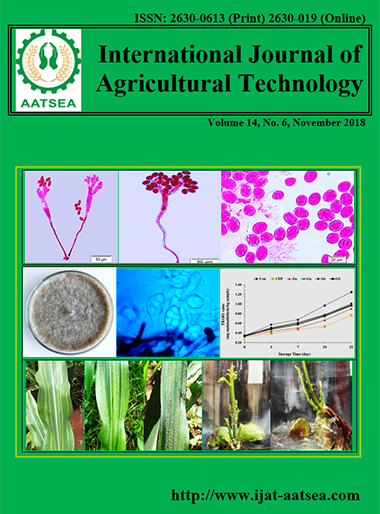Application of Nano-particles Derived from Chaetomium elatum ChE01 to Control Pyricularia oryzae causing Rice Blast
Main Article Content
Abstract
Pyricularia oryzae causing rice blast was isolated and proved for pathogenicity. Chaetomium elatum ChE01 was proved to be antagonized P. oryzae in bi-culture antagonistic test which averaged inhibition of 60.40 % within 15 days. Fungal metabolites from C. elatum ChE01 were extracted and tested to inhibit P. oryzae. Results showed that crude ethyl acetate expressed antifungal activity against P. oryzae which the effective dose50 (ED50) was 231 ppm., followed by crude methanol and crude hexane which the ED50 were 460 and 2,122 ppm. respectively. It was shown that nano-CCE gave the highest inhibition P. oryzae which the ED50 was 8.25 ppm, and followed by nano-CEM and nano-CEH which the ED50 values were 11.21 and 65.52 ppm, respectively. Further research findings are investigated in pot and field experiments.
Article Details

This work is licensed under a Creative Commons Attribution-NonCommercial-NoDerivatives 4.0 International License.
References
Dar, J. and Soytong, K. (2014). Construction and characterization of copolymer nanomaterials loaded with bioactive compounds from Chaetomium species. Journal of Agricultural Technology. 10:823-831.
Elibol, O. H., Morisette, D. D., Denton, J. P. and Bashir, R. (2003). Integrated nanoscale silicon sensors using top-down fabrication. Applied Physics Letters. 83:4613-4615.
Emmanuel, E. G., Divina, C. C. and Dar, D. J. (2013). Inhibitory activity of Chaetomium globosum Kunze extract against Philippine strain of Pyricularia oryzae Cavara. International Journal of Agricultural Technology. 9:333-348.
Li, X., Xu, H., Chen, Z. S. and Chen, G. (2011). Biosynthesis of nanoparticles by microorganisms and their applications. Journal of Nanomaterials. 16:270-974.
Perlatti, B., de Souza Bergo, P. L., das Graas Fernandes da Silva, M. F., Fernandes, J. B. and Forim, M. R. (2013). Polymeric nanoparticle-based insecticides: a controlled release purpose for agrochemicals. In S. T. Technologies (Ed.), Insecticides – Development of Safer and More Effective (pp. 20). In Tech Open Access, Croatia, Ch.
Phonkerd, N., Kanokmedhakul, S., Kanokmedhakul, K., Soytong, K., Prabpai, S. and Kongsearee, P. (2008). Bis-spiro-Azaphilones and Azaphilones from the Fungi Chaetomium cochliodes VTh01 and C. cochliodes CTh05. Tetrahedron. 64:9636-9645.
Salata, O. V. (2004). Applications of nanoparticles in biology and medicine. Journal of Nanobiotechnology. 2-3.
Sibounnavong, P., Chaoenporn, C., Kanokmedhakul, S. and Soytong, K. (2012). Antifungal metabolites from antagonistic fungi used to control tomato wilt fungus, Fusarium oxysporum f sp lycopersici. Africa Journal of Biotechnology. 10:19714-19722.
Song, J. J. and Soytong, K. (2016). Antifungal activity of Chaetomium elatum against Pyricularia oryzae causing rice blast. International Journal of Agricultural Technology. 12:1437-1447.
Soutter, W. (2012). Nanotechnology in agriculture. AZoNano.com Publishers. Available at http://www.azonano.com/article.aspx?Article ID=3141#1%204.
Soytong, K. and Quimio, T. H. (1989). Antagonism of Chaetomium globosum to the rice blast pathogen, Pyricularia oryzae. Kasetsart Journal (Natural Science). 23:198-203.
Soytong, K., Charoenporn, C. and Kanokmedhakul, S. (2013). Evaluation of microbial elicitors to induce plant immunity for tomato wilt. African Journal of Microbiology Research. 7:1993-2000.
Soytong, K., Kanokmedhakul, S., Kukongviriyapan, V., Isobe, M. (2001). Application of Chaetomium species (Ketomium) as a new broad spectrum biological fungicide for plant disease control: a review article. Fungal Diversity. 7:1-15.
Tann, H. and Soytong, K. (2016). Effects of nanoparticles loaded with Chaetomium globosum kmitl-n0805 extracts against leaf spot of rice var. Sen Pidoa. Malaysia Jounal of Application Biology. 45:1-7.
Te Beest, D.O., Guerber, C. and Ditmore, M. (2007). Rice blast. The Plant Health Instructor. DOI: 10.1094/PHI-I-2007-0313-07. Reviewed 2012.
Thohinung, S., Kanokmedhakul, S., Kanokmedhakul, K., Kukongviriyapan, V., Tusskorn, O. and Soytong, K. (2010). Cytotoxic 10-(indol-3-yl)-[13]cytochalasans from the fungus Chaetomium elatum ChE01. Arch Pharm Res. 8:1135-41.


